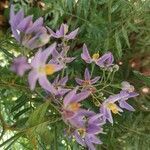Vines slender, woody, 1-5 m, glabrescent; pubescence of simple hairs. Leaves simple or pinnately compound; petiole 2-5 cm; leaf blade 4-10 × 4-7 cm, puberulent along veins, base acute, obtuse, truncate, or cordate, usually pinnately (5-)7(-9)-parted; lobes ovate to oblong or lanceolate, unequal, 1.5-5 × 0.5-2.5 cm, acute or acuminate. Inflorescences leaf opposed or appearing terminal, showy, many-flowered open panicles; peduncle to 4 cm, branched. Pedicel 5-10 mm, abscissing nearly at base. Calyx cup-shaped, 1-1.5 × 2-3 mm, truncate or with minute, short deltate lobes, glabrous. Corolla usually purple, rarely white, 0.9-1.3 cm; lobes ovate-oblong, 5-8 × 2.5-4.5 mm, glabrous. Filaments 2-3 mm; anthers free, 3-4 mm. Style ca. 1 cm. Fruit (not seen in Chinese plants) red, juicy, globose, 1-2 cm. Seeds discoid, 2-3.5 mm in diam.
Leaves solitary; petiole 1–4.5 cm long; lamina membranous, 2.5–14 × 1.5–10 cm, ovate to sometimes elliptic or obovate in outline, acute to truncate or cordate and somewhat unequal-sided at the base, subglabrous or pubescent at least along the margins and veins, and also with some glandular hairs often present beneath, mostly pinnatilobed to pinnatisect distally and pinnatisect proximally, with (3)5–7(9) lobes or segments, these 0.7–8.4 × 0.2–3.2 cm, the lowest often smaller and the upper ones mostly confluent with the rhachis, ovate to lanceolate, obovate to oblanceolate, elliptic or oblong, basally cuneate, truncate or sub-cordate and ± oblique, broadly attached to shortly stalked, apically obtuse to acute and often ± long-acuminate, entire or undulate, the sinuses broadly rounded to acute.
Sprawling perennial shrub or climber, green; simple, non-glandular hairs on leaf margins, veins of lower leaf-surface and corolla margins and tips; glandular hairs on peduncles and pedicels; prickles absent. Leaves ovate; lamina 4–13 cm long, 4–11 cm wide, concolorous, deeply lobed, the lobes often cut to midrib; petiole 2–4 cm long. Inflorescence few–50–flowered; peduncle 1–6 cm long; rachis to 10 cm long; pedicels 10–15 mm long. Calyx 1.5–2.5 mm long; lobes broad, very short. Corolla deeply incised, 20–30 mm diam., mauve-blue. Anthers 2.5–4 mm long. Berry globular, 8–12 mm diam., bright red. Seeds 2–3 mm long, reddish-brown, hairy.
A climbing vine. It grows to 3-5 m long. It is hairless and evergreen. The leaves are produced alternately along the vine and are often divided into leaflets. The leaves are 10-20 cm long and they can be entire or with 6-9 lobes or leaflets. The flowers are purple and 2 cm across. They develop in large clusters 15 cm across. The fruit are bright red berries. They are oval in shape and 6-10 mm across.
Cymes soon displaced laterally, showy, paniculiform or corymbiform, 4.5–17 cm long, ± lax, usually many-flowered, drooping, with the axes glabrous apart from a few glandular hairs; peduncle (0.5)1.5–4.5(7.5) cm long, elongated to 9 cm in fruit.
Corolla blue to mauve, purple or lilacineous, elsewhere rarely white, ± deeply stelliform, 12–29 mm across; lobes 5–12 × 2–7 mm, oblong or lanceolate, acutish from a tapering apex, with eglandular hairs along the margins and on the tip.
Calyx green to purplish upwards, 0.7–1.2 mm long, campanulate or cupular, glabrous or glandular, apically truncate or with umbonate teeth to short, deltate, obtuse lobes tipped with a few hairs, in fruit not splitting at the sinuses.
Climber, up to 6 m high, unarmed. Leaves pinnate or unequally pinnatifid, glabrous. Inflorescence a many-flowered axillary cyme. Corolla 25 mm in diameter. Berries red. Flowers blue to purple.
Ovary c. 1 mm in diameter, globose or globose-conical, glabrous or with a few glandular hairs; style 6–11 mm long, slender, straight but curved at the apex, much exceeding the stamens.
Seeds numerous, creamy to reddish-brown, 2.6–4 × 2–3.5 mm, sub-reniform or circular to obovate in outline, appearing hirsute with the remains of cell walls projecting outwards.
Climbing or trailing shrub to 6 m, subglabrous or scarcely pubescent; hairs simple, few-celled, ± curved, usually ± appressed, with tiny glandular ones also.
Stamen filaments 1.5–3.5 mm long; anthers 2–4 mm long, stout, oblong in outline, not or slightly tapering towards the apex.
Flowers ± pendulous; pedicels 5–16(19 in fruit) mm long, slender, slightly thickened upwards, abscissing near the base.
Fruit bright to deep shiny red, 7–11 mm in diameter, globose to ovoid, finally pulpy, poisonous.
Branches ± terete, slender, becoming somewhat woody.











